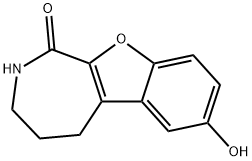| Description: |
CID755673 is a potent and selective PKD1 inhibitor with an IC50 of 182 nM. |
| Target: |
PKD1:182 nM (IC50)
PKD3:227 nM (IC50)
PKD2:280 nM (IC50) |
| In Vivo: |
Acute administration of the PKD inhibitor CID755673 to normal mice reduces both PKD1 and 2 phosphorylation in a time and dose-dependent manner. Chronic CID755673 administration to T2D db/db mice for two weeks reduces expression of the gene expression signature of PKD activation, enhances indices of both diastolic and systolic left ventricular function and is associated with reduced heart weight[2]. |
| In Vitro: |
CID755673 exhibits selective PKD1 inhibition when compared with AKT, polo-like kinase 1 (PLK1), CDK activating kinase (CAK), CAMKIIα, and three different PKC isoforms. It is not competitive with ATP for enzyme inhibition. CID755673 blocks phorbol ester-induced endogenous PKD1 activation in LNCaP cells in a concentration-dependent manner. CID755673 inhibitS the known biological actions of PKD1 including phorbol ester-induced class IIa histone deacetylase 5 nuclear exclusion, vesicular stomatitis virus glycoprotein transport from the Golgi to the plasma membrane, and the ilimaquinone-induced Golgi fragmentation. CID755673 inhibits prostate cancer cell proliferation, cell migration, and invasion[1]. |
| Kinase Assay: |
The radiometric kinase assay is carried out by coincubating 0.5 μCi of [γ-32P]ATP, 20 μM ATP, 50 ng of purified recombinant human PKD (PKD1, PKD2, and PKD3) or CAMKIIα proteins, and 2.5 μg of Syntide-2 in 50 μL of kinase buffer that contains 50 mM Tris-HCl, pH 7.5, 4 mM MgCl2, 10 mM β-mercaptoethanol. The reaction is carried out under conditions that the initial rate is within the linear kinetic range[1]. |
| Cell Assay: |
The wound-induced migration is triggered by scraping the cells with a plastic pipette tip, and the wound is imaged immediately. The DU145 cells are then are treated with or without CID755673 at different concentrations. The wound is imaged immediately (0 h) and at different intervals with an inverted phase-contrast microscope with a ×10 objective. At the end of the assay, cells are fixed with methanol and stained with crystal violet for a final image[1]. |
| Animal Administration: |
Mice: For acute inhibitor studies, C57BL6 mice are administered a single dose of vehicle (5% DMSO in PBS, pH 7.4), or the selective PKD inhibitor CID755673 at 1 or 10mg/kg body weight. Mice are killed one or four hr later and heart collected for later analysis. For chronic inhibitor experiments, 8-week old db/db mice receives vehicle or CID755673 at 1 or 10mg/kg bodyweight for 16 days, by daily intraperitoneal (i.p.) injection[2]. |
| References: |
[1]. Sharlow ER, et al. Potent and selective disruption of protein kinase D functionality by a benzoxoloazepinolone. J Biol Chem. 2008 Nov 28;283(48):33516-26.
[2]. Venardos K, et al. The PKD inhibitor CID755673 enhances cardiac function in diabetic db/db mice. PLoS One. 2015 Mar 23;10(3):e0120934.
[3]. YangLei, et al. Regulation of protein kinase D1 on the expression of eNOS and Ang1 in myocardium of rats with myocardial infartion. Journal of Jinan University (Natural Science & Medicine Edition). 2015 Dec 36 (6).
[4]. YANG Lei, et al. Promoting angiogenesis of protein kinase D1 in vitro and in vivo. Chin J Pathophysiol, 2016, 32(1): 146-150,155. |






















